My friends, we’ve got SPOILERS…right here in River City…with a capital “S” that’s, um, also the first letter of STAR TREK!
THIS!!! This is what I (and many fans) have been waiting for!
There’s no question that season 4 of STAR TREK: DISCOVERY has been their strongest start so far…although that’s not setting the bar particularly high. Season one was a train wreck. Season two was saved by ANSON MOUNT as Pike (so much so that his new Star Trek series is premiering in just a few more months). Season three started off a bit better, but dystopian futures have been done to death. That’s not what Star Trek should be about. The future is bright in Star Trek—even if there’s threats to overcome like the Borg or Dominion—it’s just knowing that the Federation is there as a beacon of hope to the galaxy that grounds Star Trek in a foundation that promises that…well…”All Is Possible.”
That’s the title of this fourth episode of season four. And it stands as proof—proof, I say!—that Discovery CAN do Star Trek…real Star Trek—not something that, if you squint just the right way, you can convince yourself is Star Trek.
So what happened?
The show hasn’t suddenly changed overnight. The evolution has been slow and steady over the four episodes of this season so far. And it’s possible that this fourth episode was a fluke and the fifth or sixth or seventh episodes (or all of them) will have the same old—or new—problems. Or this could be the start of a run of really strong episodes that make fans think, “Hey, maybe they really are finally figuring out how to do this show.”
But again, what was it about this particular episode that they get so right that they haven’t gotten right before (at least not all in one episode)? Let’s take a closer look…
PUTTING SOME OF THE BALLS AWAY
Over the past couple of weeks, I’ve talked about the episodes feeling too cluttered with conflict. Two episodes ago, all of this happened…
- Book’s emotional devastation over the destruction of his planet and loss of his family,
- Michael’s struggles balancing command with personal feelings,
- Saru’s return to Discovery,
- Tilly’s problems adjusting to her new normal,
- Adira’s uncertainty about Gray getting a new Soong-synth body,
- Stamets’ feelings of inadequacy and struggles relating to Book,
- Rescuing the officers on the damaged space station.
Then last episode, all of these plates were spinning simultaneously…
- Michael’s relationship with her mother,
- Tilly still having her existential crisis,
- Book still dealing with his pain,
- Stamets trying to figure out the anomaly,
- Gray’s consciousness now in the new synth body, but he’s not waking up,
- A rogue Romulan ninja nun with an ends-justify-the-means mentality and a badass sword.
Back in the “simpler” 60’s, TOS episodes typically had an A-story and maybe a B-story if Kirk was down on a planet and Spock or Scotty was in command back on the ship. Next Gen almost always had an A- and B-story each episode, and sometimes they’d throw in a C-story. Deep Space Nine occasionally (in the later seasons) would even push things to a D-story, as did Voyager and Enterprise if there was a big two-parter.
For Discovery, especially this season, D-stories seem to be a baseline, and we’ve seen some episodes with E-stories! As a viewer, even if it’s a fairly “quiet” episode, this many balls being juggled simultaneously can be exhausting to watch! And even though Discovery isn’t limited to just 42 or 44 minutes like most “hour”-long network shows, they still usually keep things around 50 minutes. What this means is that, in an E-story episode, each plot line gets maybe 10 MINUTES of screen time to be told. That’s not a lot (even the SHORT TREKS were usually 15 minutes).
This past episode put away a couple of balls and simply juggled three stories:
- Tilly, Adira, and Starfleet cadets trying to survive after a crash landing,
- Michael and Saru trying to find a way to bring Ni’Var (back) into the Federation,
- Dr. Hugh trying to help Book deal with the loss of his entire species and home world.
With only three stories to tell, each could “breathe” with about 17 minutes of screen time…which is 70% more than the 10 minute stories we’ve been getting. Actually, the Hugh/Book plot needed less time, giving the other two plots even larger slices of the episode…which allowed the epilogue with Tilly’s big decision to happen without feeling rushed.
More time meant more opportunity to show rather than tell (remember this lesson for writers: “show, don’t tell”?). As such, even though there still needed to be plot exposition—and there was a bit of it explaining the Ni’Var situation and why Book seemed to be doing better at the end of last episode but had slid back emotionally by the beginning of this episode—because there was more story time to have the characters DO things (even if it was just talking), it didn’t feel as though the exposition was taking up as much screen time for each story.
Similarly, it didn’t feel as though there was quite as much technobabble, even though we had a bunch of it with Tilly, Adira, and the cadets on that planet. But with more time to develop that story, the writers didn’t have to rush out a techie solution and explain it. They need to run to get to higher ground in order to get a signal out so the Armstrong could fund them. There’s dangerous, roaring monsters trying to eat them. They need to work as a team to survive. Got it? Yeah, let’s roll!
And best of all, each of the three plots FELT like a Star Trek story. Let’s take a moment to look at each one…
THE A-STORY: TILLY’S “GALILEO SEVEN“
The writers of this episode, ALAN McELROY and ERIC J. ROBERTS , actually acknowledged to director JOHN OTTMAN that the Tilly story was a huge homage to the TOS episode “The Galileo Seven.” The references were all pretty obvious—and I don’t just mean unexpectedly crashing on a needle-in-a-haystack moon while on a standard survey mission. In both the original TOS episode and “All Is Possible,” a member of the crew (in a yellow tunic, no less!) dies early and the rest are told to let him go and focus on the immediate challenge of survival and rescue. Adira removes a grate in the floor to access sensors, just as Scotty removed a grate in the floor to drain the phasers for fuel. And of course, being chased by roaring aliens trying to kill the survivors just ups the tension, urgency, and danger in both episodes.
Of course, the real “Trek“ness of the story comes from the leader (Spock/Tilly) being tested trying to keep the team together despite their doubts in their commander’s abilities and decision-making. Also, the “youngster coming of age” by having to tackle a crisis while isolated from any help is also very Star Trek, having been seen in episodes like TNG‘s “Final Mission” (Wesley has to save Picard after crashing on a desert world) and DS9‘s “Valiant” (where Jake and Nog are rescued by Red Squad cadets who are the only survivors of a starship crew, and they’re taking on the Dominion alone).
This story also allowed some of the mythos that has been built up in this new future reality to develop a little for viewers. Last season, one of the antagonists was the Orion Emerald Chain, a mafia-like criminal organization that exploited and terrorized many other alien species after the Burn. Now, an Orion is in Starfleet Academy, and not everyone is happy about that. Taking on prejudice has long been a Trek-trope—from anti-Vulcan feelings about Spock to Bajoran and Cardassian tensions, Klingon and Romulan tensions, Federation and Maquis crew members on Voyager, and even the Andorians and Vulcans on Enterprise.
Last but not least, this episode allowed Adira to do more than pine and fret over Gray or simply do advanced math on the bridge or in engineering. Adira will, it seems, be the “new” Tilly on the show, which is fine. But now, I have a better idea of who they is.
THE B-STORY: DIPLOMACY BUILDS (ON) NEW CANON
Diplomacy in the midst of state secrets, where a Starfleet captain either officially or unofficially inserts themselves into political matters, is certainly well precedented in the history of Star Trek. Captain Kirk played diplomat leading up to the events at the Khitomer Accords in Star Trek VI: The Undiscovered Country. Jean-Luc Picard became the Klingon Arbiter of Succession and got entangled in the Klingon civil war. Later on, Picard helped save Vulcan from invasion when the Romulan/Vulcan negotiations for reunification were actually a ruse. Benjamin Sisko was repeatedly involved in Bajoran politics along with helping them navigate the new “peace” with Cardassia. Later on Sisko used subterfuge to bring the Romulans in as allies during the Dominion War. And even Jonathan Archer went beyond the task of captain in helping to smooth things over between the Vulcans and Andorians, negotiating with the Xindi alliance, bringing on the Vulcan enlightenment, and even helping to form the United Federation of Planets.
So having Michael and Saru smack in the middle of negotiations between the Federation and Ni’Var was totally Star Trek. What’s more, this B-story (almost an A-story) provided both a complement and a supplement to the Tilly story. The complement was that Tilly’s survival story was fast-paced action/adventure/peril. The Ni’Var story was relaxed and thoughtful. These two storylines balanced the episode very nicely, giving the audience a chance to catch their breath each time things with Tilly’s Toddlers got really intense.
It supplemented the A-story in further expanding and building upon this new future galaxy that the writers have created. While Tilly’s plot line dealt with rebuilding Starfleet and overcoming the learned prejudices instilled by the after-Burn dystopia, Michael’s story dealt with rebuilding the Federation and overcoming the rampant distrust and paranoia instilled by the after-Burn dystopia. With Tilly, we learn more about the Orion Emerald Chain and what the rest of the galaxy thinks of them. With Michael, we learn more about Ni’Var and what they think of the Federation. In other words, welcome to future—here’s some more background information for the wiki pages.
The Ni’Var story also allowed two intriguing character relationships to develop in satisfying and promising ways. The first was Saru and Ni’Var President T’Rina. Whether this turns into some kind of romance or just a deep connection remains to be seen, but both characters are made more interesting by the added presence of the other. This will help develop Saru even further and provide a Starfleet connection to Ni’Var beyond simply Michael having been raised on Vulcan.
And speaking of Michael, of course she once again flies to the rescue (this is Star Trek: Discovery, after all), but we’re treated to a little extra in developing her relationship with Federation President Rillak (whom we have now confirmed is at least partly Cardassian…likely with a little Bajoran thrown in…maybe some human or other?). Rillak’s first appearance in the season premiere made some fans suspicious that she would be a micro-manager and perhaps a foil for Michael Burnham, not trusting the hot-headed, newly-minted captain from another time to get the job done in the 32nd century. But now we’ve discovered another aspect of Rillak, and her developing relationship with Michael is just as intriguing as the budding relationship between Saru and T’Rina.
This two-fer of developing both Michael AND Saru (and two semi-regular recurring characters) in one B-story is one of the advantages of telling fewer stories with more time for each. The writers can work more characters into the narrative and do them all justice. This was also true for the Tilly A-story, which allowed Adira to develop a bit, as well.
THE C-STORY: SHIP’S COUNSELOR
Star Trek didn’t start out dealing with grief or trauma beyond a single episode. Back in 1967, Kirk lost Edith Keeler and was fine by the next episode. In fact, it wasn’t until the fourth season TNG episode “Family” that characters were finally allowed to experience a little PTSD—primarily a post-Locutus Picard but also Worf dealing with his discommendation (with a little help from his human parents) and Wesley getting the C-story hearing a message from his late father.
From that point on, Star Trek allowed characters to suffer loss at their own speed across multiple episodes. We got to see Nog dealing with the horrors of war, Worf dealing with the loss of Jadzia, Trip dealing with the loss of his sister…just to name a few. Nothing was rushed.
Then Discovery happened, and EVERYTHING was rushed—at least, in the first two or three seasons. It was one of my biggest complaints: characters went through traumatic experiences and then there was a sprint to the next major plot beat, and no one ever seemed to have an opportunity to emotionally react to or deal with the impactful life event that had just happened to them.
This season is finally changing that, for the better, and Book is a perfect example. The man has just lost his entire planet! Family, friends, favorite tree…all gone. That’s pretty heavy stuff, and Dr. Culber is helping Book deal with that loss the way that Counselor Troi helped Picard after Locutus or after his torture by Gul Madred in “Chain of Command, part II.” (C’mon, the man actually saw five lights at the end!!!)
Anyway, Culber is doing his best here—he’s a trained physician, not a psychologist, dammit. But he’s making a difference, and apparently, he’s got some trauma of his own still to deal with…and he might just tell Book about it someday (but not today). Good. Leave the audience wanting more—the same way we want more Saru/T’Rina and more Michael/Rillak. Bravo!
LET’S TALK TILLY
I can’t NOT talk about the 800-pound mugato in the cave (no, that is not a fat joke!), so I’d like to take a moment to discuss Tilly’s leaving Discovery—the ship, not the series…MARY WISEMAN is staying with the show. Most fans found this abrupt departure somewhat shocking, although the show has certainly been telegraphing it for the past few weeks.
But I’ve seen some folks complaining that the move doesn’t make sense. After all, from the moment we first met her, Tilly has always been the one who was the most determined to rise quickly through the ranks. And now she has—already a lieutenant, having served briefly as first officer even. Of course, there are a lot of ranks left before captain… so why stop now?
Actually, this sort of thing isn’t unheard of in Star Trek. Wesley Crusher, who always dreamed of being an officer like his father and Captain Picard, decided to leave Starfleet Academy before graduating. Jake Sisko decided he didn’t want Starfleet at all and preferred pursuing journalism. Nog, on the other hand, surprised nearly everyone and actually joined Starfleet!
And teaching at Starfleet Academy isn’t unprecedented either for a young lieutenant. Heck, Kirk did it. Spock taught at the Academy later in life. So I say: let’s see where Tilly’s new path takes her. And to be honest, she wasn’t really growing much as a character anymore on the starship Discovery. Now that Saru is back and serving as first officer, Tilly is left to be the wunderkind and jester…and yet she’s really not either anymore. That’s now Adira. Tilly has grown up quite a bit, and relegating her character to just doing quick math in a crisis and providing a shoulder for Michael to cry on isn’t very compelling television. So yes, Tilly, let’s get you out of your comfort zone!
LOOK, MA: NO F-BOMBS!
One of the reasons (or more than one, actually) that I liked this episode so much was because of all the things it DIDN’T have. There were no F-bombs or S-bombs. Yeah, Culber says “a long-ass time,” but maybe he’s just talking about a large donkey wearing a watch. Also not present in the episode were any recurring bursts of flame spitting out from vents on the bridge, nacelles being detached, or shots of the sprawling expanse of empty space inside of the ship around of the turbolift shafts…in other words: anything that really bugs me that I can’t do anything about!
One other thing mostly missing from the episode: darkness. This show is usually under-lit in many scenes…often in places that should be bright like the bridge—who wants to work in a dark, depressing office all day long???—or sickbay where doctors need light to operate. Star Trek has always tended to be bright…granted not as bright and over-lit as Next Gen, but not depressingly dark. However, this episode contained brightness in the Tilly A-story and the Ni’Var B-story, which made it physically and emotionally easier for me as a viewer to watch. Only the scenes with Culber and Book were dark because Book is in a dark, quiet place…and so that worked, too.
THE ONE “BAD” THING
I’m going extra long this time, so I’ll end this quickly with my only big peeve of the episode: Michael is now too valuable to risk! The only thing now keeping Ni’Var in the Federation is Michael Burnham on the oversight committee (or whatever it is). So if she goes off on a dangerous mission and doesn’t return, there goes one of the Federation’s most important alliances!
I know that Michael Burnham is contractually obligated to save the day at least once per episode, but now whenever I see the Federation president allowing Discovery to even leave space dock, I’m going to be VERY dubious and have to suspend my disbelief.
But aside from that, I’d say this episode nailed it—totally Star Trek…finally!



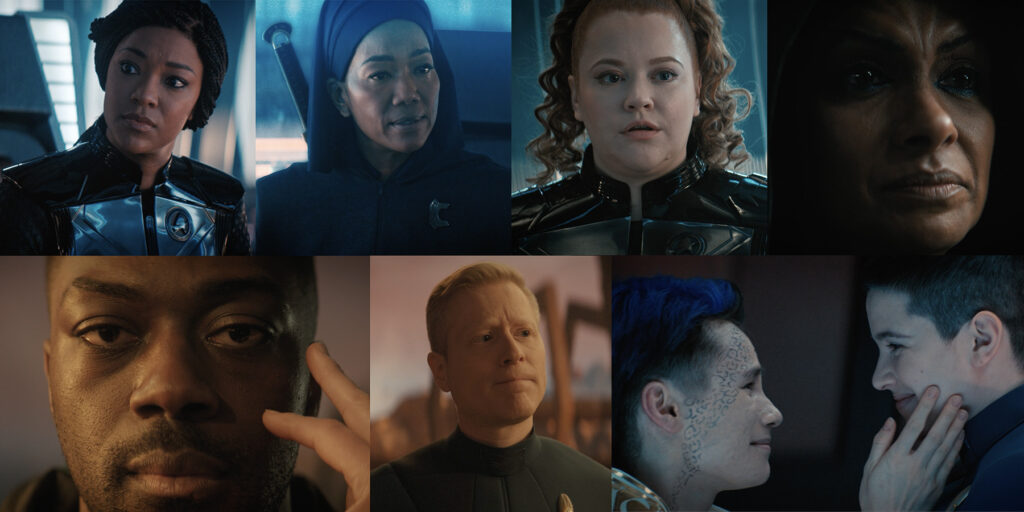
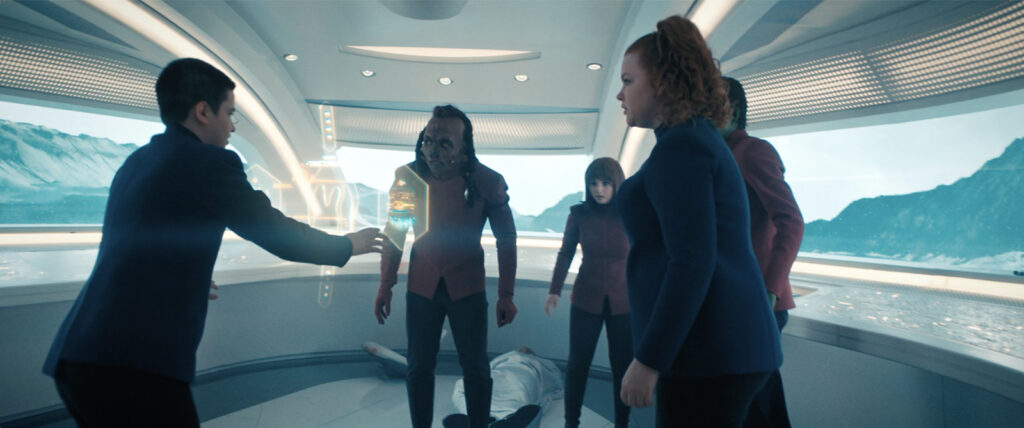
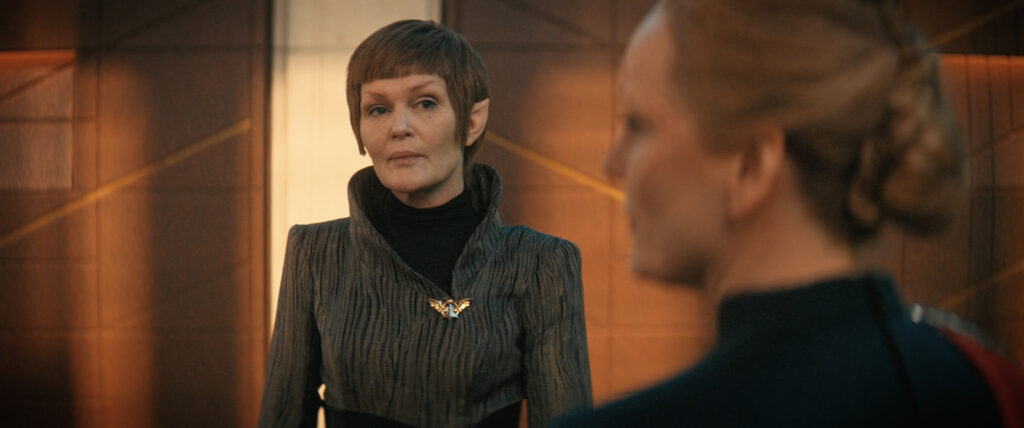
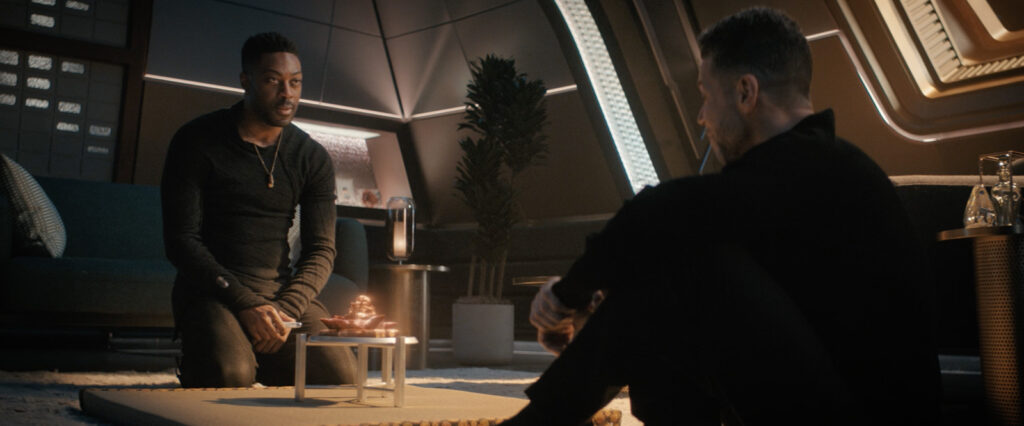
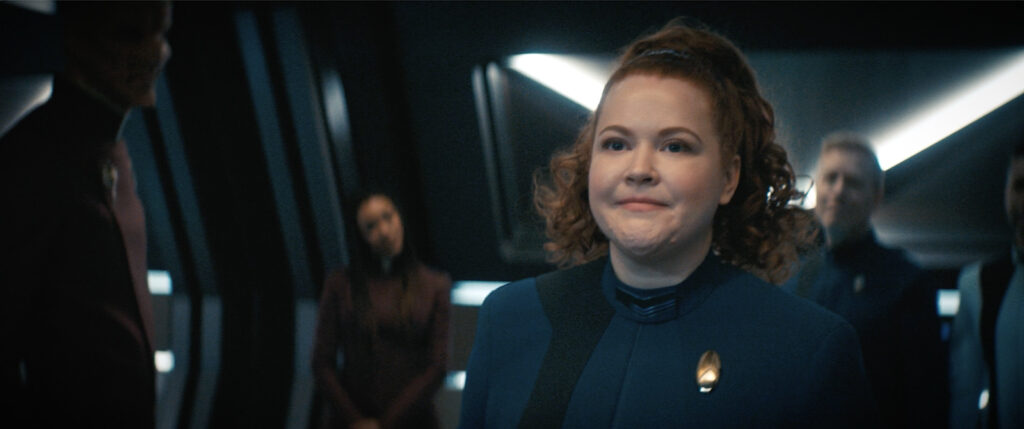
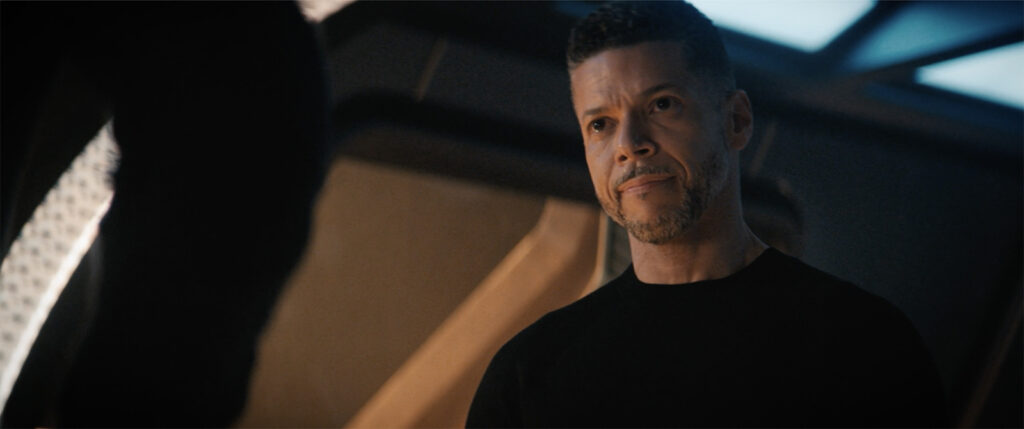
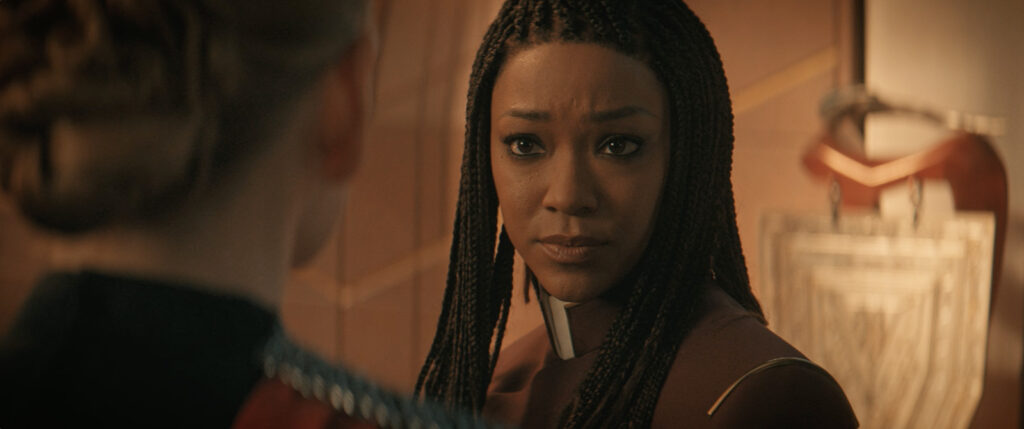
Firing on all cylinders I’d say! Even though, I’m still not a fan of The Federation President, this episode was definitely better for that character. As for Adira now becoming the “court jester” I sincerely hope this don’t last long. With all those previous lives she has within her, why she wouldn’t be acting older than her years is beyond me. I definitely like where Saru is headed. And I’ve been a fan of his character from the start.
PS. Thanks for adding the subscription to posts back to this section again.
Actually, I just toggled something on Jetpack and the subscription e-mails started going out again. YAY! (Still have no idea exactly what I did.)
As for Adira acting “older and wiser,” Ezri Dax didn’t. Remember that a symbiont and host SHARE their minds, and that means a young, insecure mind gets a say in being, as well.